The VERY SIMPLE way to prevent garbage getting in to your fuel Pulsoid, is to MAKE SURE that the fuel tank and lines are PERFECTLY CLEAN before adding any fuel and then to FILTER the fuel AS YOU FILL THE TANK.
Not doing so and either running without a filter in the system or adding a filter to the system, both carry risks and as the addition of a filter (that could become blocked or partially restricted), carries the greatest risk we strongly advise against that.
With the above in mind the following is a report about a situation we've just encountered with an American customer.
We recently had a dumbass American customer ‘claim’ that a HUGE CHUNK of debris, that he’d found stuck between the plunger and the seat of his fuel Pulsoid, had originated from the assembly. He’d then bought a replacement plunger (that he didn’t actual need to do) and it should be therefore be covered by our warranty.
After seeing the HUGE size of the debris it was obvious that it was IMPOSSIBLE for it to have been inside the Pulsoid before it left our premises and I pointed out to him that as we don’t recommend the use of filters (as the potential damage from a blocked filter is worse than the problems caused by not having a filter, is far worse) and therefore don’t fit one, that the debris was much more likely to have come from outside the Pulsoid.
Unfortunately the customer wasn’t smart enough to appreciate these FACTS and went on his Facebook page talking a bunch of garbage, about how WON was at fault for HIS problem and posted GUESSES, as to how this HUGE CHUNK of metal ended up where it did.
He eventually concluded that what he INCORRECTLY believed was a METAL SCREW (which was actually the PLASTIC outlet seat), had broken off a piece of the threads when WE had screwed the part in to the Pulsoid body but as that was IMPOSSIBLE, I sent him the following details in a private email, to inform him that he was TOTALLY WRONG and to ask him to be man enough to admit that was the case on his Facebook page.
Despite providing all the following INDISPUTABLE FACTS the asshole is either too stupid to understand them and/or not man enough to admit his mistake, so I’ve had to post this report to inform others, who may be inclined to believe his STUPIDITY.
This is the information I provided him and I’m sure that the SMART guys who read this will fully appreciate the FACTS of the matter;
What you claim to be the cause of the leak you suffered is physically IMPOSSIBLE and here are some FACTS TO PROVE IT, that I hope you will take the time to read and consider;
1) ALL the components ENTER the Pulsoid body from the OPPOSITE end to the end you claim the part of the thread has broken from, as you can see from the exploded diagram and rough sketch of an exploded Pulsoid below;
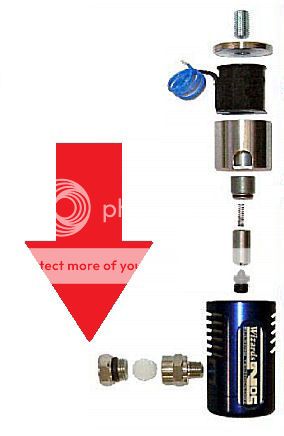
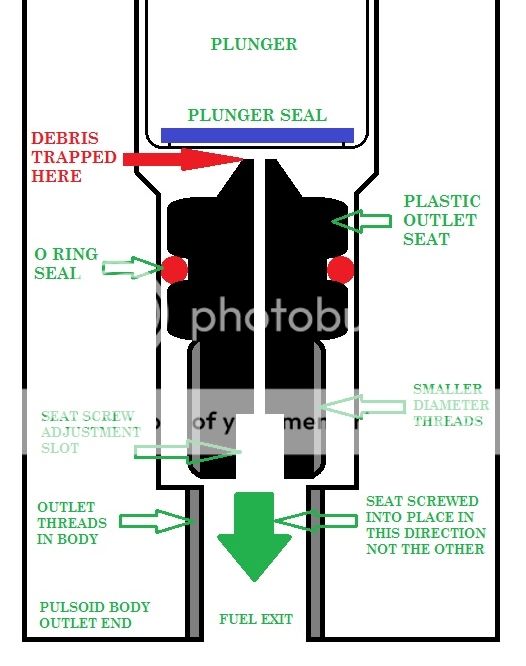
2) This means that IF any debris was either in the outlet threads or was broken from the outlet threads, it would be PUSHED OUT of the Pulsoid outlet, as the threaded part (the OUTLET SEAT) was screwed in to place.
3) Additionally, the outlet seat is made of SOFT PLASTIC, so even if it were fitted from the end you ‘think’ it is, it would be THE PLASTIC SEAT THAT WOULD BE DAMAGED by any METAL thread fragments, as the metal is OBVIOUSLY MUCH HARDER.
4) If you doubt any of this information about the seat, you can prove it all for yourself by;
i) Trying to remove the seat from the outlet end (which you won’t be able to do, therefore it can’t have been screwed in that way on assembly),
ii) If you do try to do that, you will damage the drive slot VERY EASILY, which will prove that it’s made from SOFT PLASTIC.
5) For the movement of the debris to be the REVERSE of the direction of the motion you ALLEDGE has caused a section of debris to be moved, it would have to BREAK a number of the laws of physics.
6) Furthermore, the sealing end of the outlet seat which is ABOVE the threaded section is a MUCH BIGGER DIAMETER, than the threaded end and also has an integral seal. It is therefore IMPOSSIBLE for such a large piece of debris to get past that and even if it somehow managed to do that, it would also have to get passed a SEAL in the circumference of the larger section WITHOUT DAMAGING IT (otherwise fuel would leak out constantly), to get to the location you found the debris in - See diagram below;
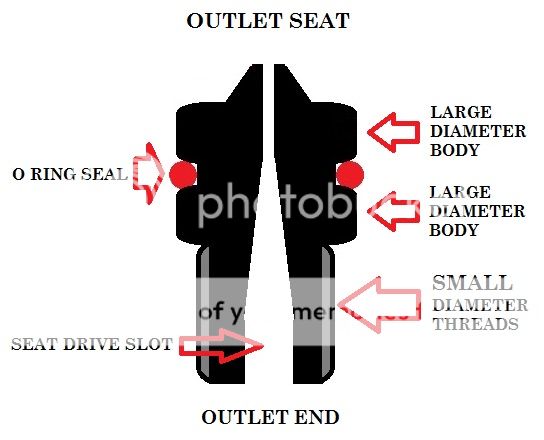
7) If all the above is not adequate proof that the debris did NOT come from the thread you ‘claim’ it did, I would further point out that the thread sizes we use (which are metric FINE) are EXTREMELY FINE (approx. 0.020” thick), so even IF an entire ring of thread were to break off, it would just crumble, as it wouldn’t have enough cross sectional area to stay in one piece.
8) I estimate that CHUNK of metal to be at least 0.060” wide, which makes it far bigger than a piece of the thread from our Pulsoid, plus it has withstood being trapped by the force of the plunger/spring without breaking up.
9) Also the diameters of the threads we use are VERY SMALL, so even a full thread would be much shorter than that chunk of metal and again as a consequence it would just crumble if it were trapped between the seat and the plunger.
10) Assuming you are still not convinced, even IF that chunk of metal had been a loose part from the machining process (and then been missed by our STRINGENT inspection team), one aspect of the anodising process you are probably not aware of, is that all components are subjected to a SEVERE CLEANING PROCESS, as the metal must be 100% free of oil, grease and debris for the anodising to embed in the metal, therefore ANY debris that might have been on the Pulsoid after machining, would CERTAINLY NOT have been there after that cleaning process, otherwise the anodising would have been process would have failed.
11) Furthermore, if it had managed to cling on through the cleaning process, it would have been COMPLETELY anodised red, along with the rest of the body and it would STILL BE COMPLETELY RED NOW, as our anodising will NOT wash off whatever fuel you use and that’s even after many years of use. If that were not the case the whole of the Pulsoid internals would be bare metal as well by now, which they won’t be but you’re welcome to check that for yourself to confirm it.
12) We don’t fit filter screens in to our fuel Pulsoid filter housings, because the consequences of a blocked filter are greater and more dangerous, than not having a filter. However, this does mean that there will be a high probability that debris FROM THE FITTING PROCESS AND/OR THE FUEL SUPPLY, will find its way in to the Pulsoid but most people appreciate this is a risk they have to take.
13) Even if you disregard ALL the above FACTS, just using the laws of probability and common sense, the fact that you were not using a filter, makes debris from an external source the MOST LIKELY SOURCE.
14) With that being the case, I’ve magnified your picture of the plunger seal face and beside the indentation caused by the chunk of metal, there is a number of smaller particles of debris embedded in the sealing area (trapped when the plunger closes), which PROVES your fuel system is far from clean, as you can see in your original picture that I’ve added pointers to the debris to below;
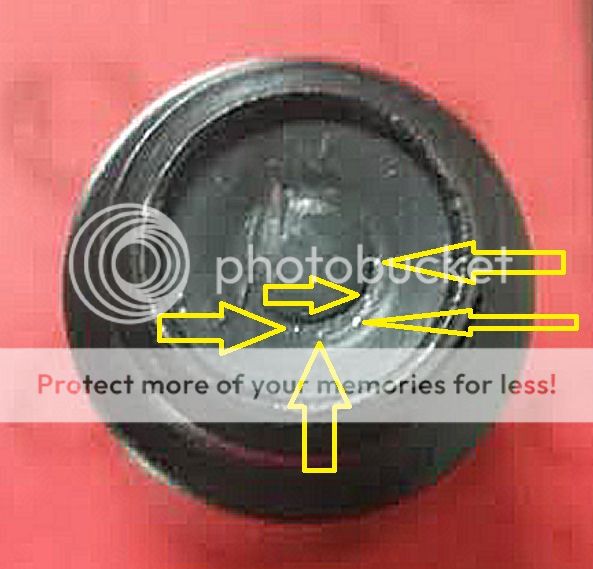
15) What you also need to keep in mind, is that if you continue to deny the debris came from outside the Pulsoid and you do nothing to find the ACTUAL SOURCE, there may be other debris where that came from, that will cause a repeat of the problem in future and if it causes the Pulsoid plunger to stay wide open, you could end up with your engine suffering a hydraulic lock, that could WRECK YOUR ENGINE.
As I stated in my opening email, I am SOLELY responsible for inventing, designing and manufacturing, as well as having used my Pulsoids personally, so there should be NO DOUBT that I am the most knowledgeable person on every aspect of their construction and function, anyone who thinks that’s boastful or arrogant is a FOOL, as it’s just a simple FACT and basic logic.
Furthermore, I have sold many thousands of Pulsoids over the past 30 years and NOBODY has ever reported anything even SIMILAR to that CHUNK of metal being found inside one before.
Therefore, using the laws of probability again, it is HIGHLY UNLIKELY that after all those have been sold, that JUST ONE would MIRACULOUSLY produce a CHUNK of metal debris that;
1) Is FAR TOO BIG to originate from the Pulsoid itself, especially to be part of one of the VERY SMALL threads
2) Has MIRACULOUSLY stayed inside the Pulsoid through the STRINGENT cleaning process
3) Then failed to be anodised FULLY or has almost instantly lost its full anodised colour
4) Has then MIRACULOUSLY stayed inside the Pulsoid through the STRINGENT inspection, building, assembly and testing processes, without being noticed and without affecting either the assembly or testing itself
5) Then it was MIRACULOUSLY broken off by a SOFT PLASTIC seat thread
6) And then managed to MIRACULOUSLY move in the reverse direction to the action that allegedly broke it off and find its way past a section of larger diameter and past a seal WITHOUT DAMAGING IT, DEFYING NUMEROUS LAWS OF PHYSICS IN THE PROCESS!!!!
In contrast to the string of MIRACLES listed above and the breaking of the laws of Physics, the SIMPLE AND HIGHLY PLAUSIBLE alternative, is that the debris SIMPLY entered the inlet when the hose was being connected (as we’ve seen evidence of MANY times), or it was washed in through the inlet with the fuel, again something we have seen evidence of MANY times before.
The diagram below shows the relative location of the INLET to the location of the plunger seal, seat tip and where the debris was located, which as you can see would be far from a miracle path for the debris to take to get there and would in fact be almost IMPOSSIBLE for it to end up anywhere else;

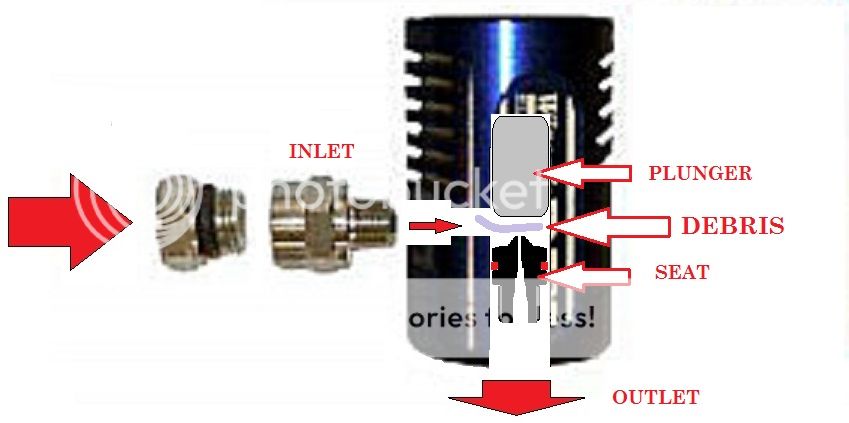
Finally this is a fully detailed exploded picture of a complete Pulsoid;

In closing, if you STILL refuse to accept that the debris came from outside of the Pulsoid, I invite YOU to provide ABSOLUTE PROOF (by way of pictures, etc), that the debris came from inside the Pulsoid and explain exactly how it got there, NOT in the form of a GUESS as you’re currently relying on or the OPINIONS of people who have never even seen a Pulsoid but in the way that I have provided comprehensive proof to you, to support my assertions of the FACTS.
Regards
Trevor Langfield.
This dumbass fool hasn't even had the decencies to reply to my email, never mind send me ANY PROOF to support his ILL INFORMED GUESS WORK and still hasn't been man enough TO ADMIT THAT 'HE' IS WRONG!!!!
I'd like to end this post by stating how thankful I am that 99.9999% of my customers are not only smart enough to choose WON products but also smart enough to know what to expect when NO filters are used.




